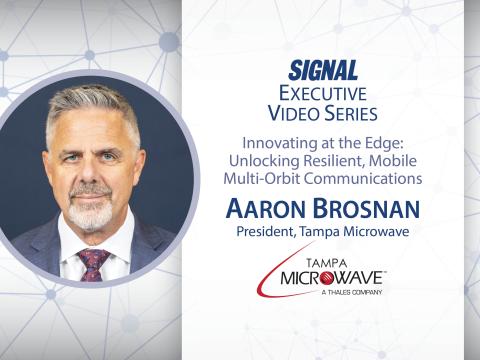Shipboard and Land Networks to Become Shipmates
The Navy is developing the new CANES shipboard network with its land-based cousin in mind.
Walk up to a terminal, swipe a card and log in to a single, consolidated network architecture. That is the future the Navy envisions for its sailors when they disembark after a deployment and want to use a network on land, or vice versa—something that is difficult to do in today’s environment of cluttered legacy networks.
The Navy is trying to move away from having numerous networks that each have their own hardware and requirements, making it expensive to replace and difficult for sailors to move from one network to the other. As part of that effort, the Consolidated Afloat Networks and Enterprise Services (CANES) will consolidate myriad shipboard networks beginning in 2012 into one software-based, open-architecture system that is flexible and adaptable.
One of the key benefits of CANES will be its interoperability with its land-based cousin, the legacy Navy-Marine Corps Intranet (NMCI)—as well as with the NMCI’s eventual replacement in the middle of this decade, the Next-Generation Enterprise Network (NGEN).
Today, sailors use what is known as a Common Access Card (CAC), a smart card that serves as standard identification for U.S. Defense Department personnel and enables access to certain computers and networks. The Navy wants the sailor to plug the CAC card into both CANES and NGEN to obtain access simply and seamlessly, and is holding regular design and engineering meetings to make that happen, according to Capt. D.J. LeGoff, USN, program manager of the tactical networks program office at the Navy Program Executive Office for Command, Control, Communications, Computers and Intelligence. Capt LeGoff is responsible for the CANES program.
One of the trickier realities of developing this kind of interoperability between networks is the fact that the NMCI is operating under a continuity-of-services contract that pushes NGEN out into the middle of the decade. The original contract for NMCI was supposed to expire last October, but the Navy signed a continuity-of-services contract with manufacturer Hewlett-Packard Company to keep the 10-year-old network running until fiscal year 2014 while the Navy develops NGEN and then gradually phases in the architecture.
The Navy begins CANES installation aboard ships in 2012, however, so the time lines do not match up. “That makes it difficult to align from a contractual perspective,” Capt. LeGoff says. “But we do have routine technical exchanges.”
Two contractors—Lockheed Martin Corporation and Northrop Grumman Corporation—currently are competing for CANES work. Mike Twyman, vice president for integrated command, control, communications and intelligence systems at Northrop Grumman Information Systems, says that despite the timing, the company is working to make sure CANES will play well with other networks.
“Our solution is designed to interface with the NMCI and, based on what we’ve been given about the plans for NGEN, we’re aligned with NGEN as well,” Twyman explains. “The vision we have is … for a sailor anywhere, anytime, that they’re plugged into a network. They shouldn’t be able to tell if they’re on a CANES network or an NMCI or NGEN network.”
Jill Kale, a Northrop Grumman vice president in the company’s Defense Enterprise Solutions Business unit, says the Navy has laid out a good integration plan that takes advantage of the slow transition from the legacy NMCI network to NGEN to integrate the land-based network with CANES.
“We’re looking forward to seeing how NGEN is going to be architected, and we’ll be able to support both platforms: the current continuity-of-services and, most importantly, NGEN,” she emphasizes.
Joe Villani, Lockheed Martin’s CANES capture executive, says in an e-mail that the company also is working toward a solution that integrates CANES and land-based networks. Lockheed’s offering also will be flexible and open, enabling quick upgrades to adapt to the current needs of the Navy, he states.
“We have developed a solution that supports the U.S. government’s needs to manage [commercial off-the-shelf]-based systems, and the logistics associated with these systems,” Villani says. “Our CANES Technology Insertion Program (CTIP), combined with our modular open-systems architecture, will enable rapid technology insertion to meet the U.S. Navy’s future critical computing needs.”
Meanwhile, the competition between the two companies continues in advance of an initial system design award this summer. Early last year, Lockheed and Northrop Grumman received contracts worth potentially $937 million and $775 million, respectively. The awards cover initial CANES infrastructure development.
Capt. LeGoff says the contractors will need to figure out a way to replace five legacy shipboard networks. “Each one of those grew up separately—has different requirements documents, different funding streams,” he explains. “As a result of the genesis of those legacy networks, they also all have different hardware and software infrastructure.”
This creates numerous complications not just for Navy officials and commanders, but also for the individual sailors, the captain says. “It’s a difficult thing to manage with all the parts and pieces on a ship, and the users are often left to fend for themselves.”
CANES came about as a part of program objective memorandum 2008 deliberations in the Navy when officials decided the service should have a single network architecture that would be common across all systems. “As we do that, we wanted to take as little technical risk as possible,” Capt. LeGoff says.
To minimize that risk, the statement of work mandates commercial off-the-shelf hardware and software, and it mandates open standards and that the government own all rights to the architecture. That means that even if one of the contractors wins the award to build the initial system, the other contractor can come in later and win an award to continue to upgrade and develop it, which helps foster competition, the captain says.
“We will control the entire data package,” Capt. LeGoff says. “It’ll keep us from getting locked into any particular brand or vendor or innovator. That addresses what we’re trying to do—reduce the risk through open standards and government open data rights,” he continues. “And we’re going to do constant competition across the life cycle of this program. That’s how we think we can do the best job to keep the costs down.”
The program will downselect to one competitor in July to build the initial system following a 14-month competition, which started with the contract awards early last year. “We’re going to downselect not to a prime—we’re going to downselect to a design,” he says.
Capt. LeGoff says the program is not run in the traditional way. “This is a pretty fast-moving train,” he asserts. “I think this is a really good example of the ability to do things quickly in a [Defense Department acquisition policy] 5000 environment. [The Office of the Secretary of Defense] has been working with us to help us go as fast as possible.”
Villani says Lockheed continues to “execute on the system development and design phase of the competition and work toward the final downselect later this year.” He adds that the company recently populated its integration facility with the Lockheed CANES solution. “We have also begun initial qualification testing,” he says.
Twyman says Northrop Grumman has submitted its design for the critical design review, which was scheduled for late February. “In parallel, we’re also going through environmental qualification testing for some of the larger elements of the program,” he says. “Then, basically we’re on time to go through with [what is] essentially system testing and then develop a test report.”
The government is saying that the July contract award will be for “limited early installation for fleet evaluation of the CANES system,” Twyman says.
Villani says Lockheed’s version of CANES will “support the secure afloat network required for naval and joint operations by consolidating and reducing the number of afloat networks through the use of mature cross-domain technologies and common computing environment infrastructure.
“Additionally, our goal is to reduce the infrastructure footprint and associated costs for hardware afloat, and to provide increased reliability, application hosting and other capabilities to meet current and projected warfighter requirements,” Villani adds.
He says such a solution would increase efficiencies through integrating legacy and stand-alone afloat networks by “providing adaptable, responsive [information technology] platforms,” the end goal being to create a “modern, holistic network that is modular, scalable and secure.”
Twyman says Northrop Grumman’s solution for CANES will provide “significantly more computing and network capability on ship so the current and planned applications—depending upon the ship class—[represent] a reduction in the size, weight and power required to host a greater computing capacity.”
The system also will be easier for sailors to use and maintain, Twyman says, and the company also is looking at some extra capabilities.
“In addition to pure networking, we’re looking at the information assurance and systems management across the enterprise,” he states. “We’re also looking at federated command and control capabilities, so that the ship-to-ship and ship-to-shore can collaborate together to improve speed of command for the operators in the fleet.”
Capt. LeGoff expects that the result of the competition will be a network architecture that has a variety of improvements over legacy systems.
“Besides addressing obsolescence issues, besides bringing a refresh of technology, CANES brings two specific capabilities,” the captain says. “The first is it is the only fully funded computer network defense program in afloat Navy where the full requirements to support information assurance are built into the program. The second piece is we’re spending a lot of time and attention on the system management of this network, this secret sauce, if you will, on how you put together all these disparate boxes in the network—how we reduce workload on the administrator.”
Daniel P. Taylor is a freelance writer.




Comments